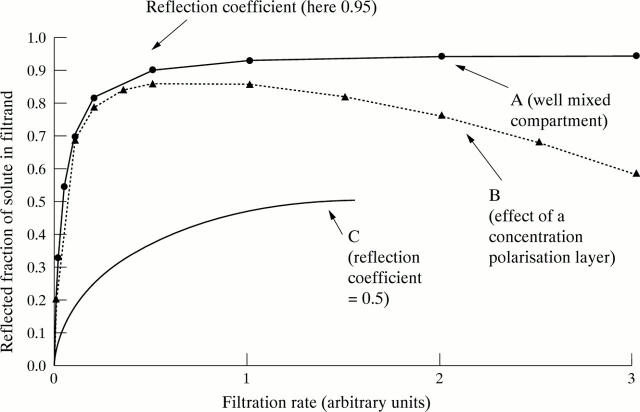Abstract
Recent studies show that very large macromolecules in synovial fluid, such as hyaluronan and large proteoglycans, are partially reflected by the synovial lining during fluid drainage, and thus selectively retained within the cavity. Size selective molecular reflection is a fundamental property of membranes, and a method for quantifying the reflective behaviour of human synovium could be of value in several pathophysiological areas. The method proposed here is based on the intra-articular half lives of the macromolecule of interest and of a smaller, easily cleared protein such as albumin. The key relation is derived from the law of conservation of mass, using simple algebra. It is found that, when the intra-articular half lives of albumin and a macromolecular test solute are determined simultaneously, the reflected fraction of the test solute is given by the complement of the half life ratio. Examples are given. Intra-articular half lives can thus be used to consider such questions as whether immune complexes are significantly reflected by the synovial surface, how the reflective property changes in arthritides or with treatment, and how significantly reflection might influence the intra-articular concentration of large "markers" of joint disease activity.
Full Text
The Full Text of this article is available as a PDF (140.9 KB).
Figure 1 .
Schematic diagram to illustrate relation between intra-articular concentration of a macromolecule, fluid turnover rate (dV/dt) and partial molecular reflection at the synovial surface. The term dm/dt is the rate of entry of the macromolecule into the synovial cavity, R is the fraction of the macromolecules in the escaping fluid that is reflected and E is the escaping fraction.
Figure 2 .
Effect of reflected fraction R upon the concentration of a macromolecule in synovial fluid. Based on law of conservation of mass, equation [3a]. Curve A shows concentrations for a macromolecule that enters the joint at a rate (dm/dt) of 0.1 mg/h, with an accompanying volume turnover rate (dV/dt) of 1 ml/h. Its concentration in the steady state is 0.1 mg/ml if the reflected fraction is zero, but 1 mg/ml if the reflected fraction is 0.9. Curve B shows the effect of doubling the macromolecular input rate, or of halving the fluid turnover rate. Curve C shows the effect of doubling the fluid turnover rate, as commonly happens in arthritides.15
Figure 3 .
Relations between reflected fraction and filtration rate for a simple homoporous membrane. The reflected fraction of the solute approaches a limit, called the reflection coefficient, as filtration rate increases. Curve A. Perfectly stirred fluid upstream of membrane, and a membrane reflection coefficient of 0.95. Based on Patlak et al.20 Curve B.The effect of a concentration polarisation layer developing near a partially reflective membrane in a poorly stirred cell. This causes the relation to deviate at high filtration rates. Curve C. As for curve A but for a membrane of reflection coefficient 0.5.
Selected References
These references are in PubMed. This may not be the complete list of references from this article.
- Coleman P. J., Scott D., Ray J., Mason R. M., Levick J. R. Hyaluronan secretion into the synovial cavity of rabbit knees and comparison with albumin turnover. J Physiol. 1997 Sep 15;503(Pt 3):645–656. doi: 10.1111/j.1469-7793.1997.645bg.x. [DOI] [PMC free article] [PubMed] [Google Scholar]
- Jensen L. T., Henriksen J. H., Olesen H. P., Risteli J., Lorenzen I. Lymphatic clearance of synovial fluid in conscious pigs: the aminoterminal propeptide of type III procollagen. Eur J Clin Invest. 1993 Dec;23(12):778–784. doi: 10.1111/j.1365-2362.1993.tb00731.x. [DOI] [PubMed] [Google Scholar]
- Levick J. R. An analysis of the interaction between interstitial plasma protein, interstitial flow, and fenestral filtration and its application to synovium. Microvasc Res. 1994 Jan;47(1):90–125. doi: 10.1006/mvre.1994.1007. [DOI] [PubMed] [Google Scholar]
- Levick J. R., McDonald J. N. Fluid movement across synovium in healthy joints: role of synovial fluid macromolecules. Ann Rheum Dis. 1995 May;54(5):417–423. doi: 10.1136/ard.54.5.417. [DOI] [PMC free article] [PubMed] [Google Scholar]
- Levick J. R., McDonald J. N. Viscous and osmotically mediated changes in fluid movement across synovium in response to intraarticular albumin. Microvasc Res. 1994 Jan;47(1):68–89. doi: 10.1006/mvre.1994.1006. [DOI] [PubMed] [Google Scholar]
- Myers S. L., O'Connor B. L., Brandt K. D. Accelerated clearance of albumin from the osteoarthritic knee: implications for interpretation of concentrations of "cartilage markers" in synovial fluid. J Rheumatol. 1996 Oct;23(10):1744–1748. [PubMed] [Google Scholar]
- Page-Thomas D. P., Bard D., King B., Dingle J. T. Clearance of proteoglycan from joint cavities. Ann Rheum Dis. 1987 Dec;46(12):934–937. doi: 10.1136/ard.46.12.934. [DOI] [PMC free article] [PubMed] [Google Scholar]
- Patlak C. S., Goldstein D. A., Hoffman J. F. The flow of solute and solvent across a two-membrane system. J Theor Biol. 1963 Nov;5(3):426–442. doi: 10.1016/0022-5193(63)90088-2. [DOI] [PubMed] [Google Scholar]
- Prehm P. Synovial hyaluronate in rheumatoid arthritis binds C1q and is covalently bound to antibodies: a model for chronicity. Ann Rheum Dis. 1995 May;54(5):408–412. doi: 10.1136/ard.54.5.408. [DOI] [PMC free article] [PubMed] [Google Scholar]
- Scott D., Coleman P. J., Mason R. M., Levick J. R. Direct evidence for the partial reflection of hyaluronan molecules by the lining of rabbit knee joints during trans-synovial flow. J Physiol. 1998 Apr 15;508(Pt 2):619–623. doi: 10.1111/j.1469-7793.1998.619bq.x. [DOI] [PMC free article] [PubMed] [Google Scholar]
- Simkin P. A., Benedict R. S. Iodide and albumin kinetics in normal canine wrists and knees. Arthritis Rheum. 1990 Jan;33(1):73–79. doi: 10.1002/art.1780330109. [DOI] [PubMed] [Google Scholar]
- Wallis W. J., Simkin P. A., Nelp W. B., Foster D. M. Intraarticular volume and clearance in human synovial effusions. Arthritis Rheum. 1985 Apr;28(4):441–449. doi: 10.1002/art.1780280413. [DOI] [PubMed] [Google Scholar]
- Wallis W. J., Simkin P. A., Nelp W. B. Protein traffic in human synovial effusions. Arthritis Rheum. 1987 Jan;30(1):57–63. doi: 10.1002/art.1780300108. [DOI] [PubMed] [Google Scholar]





